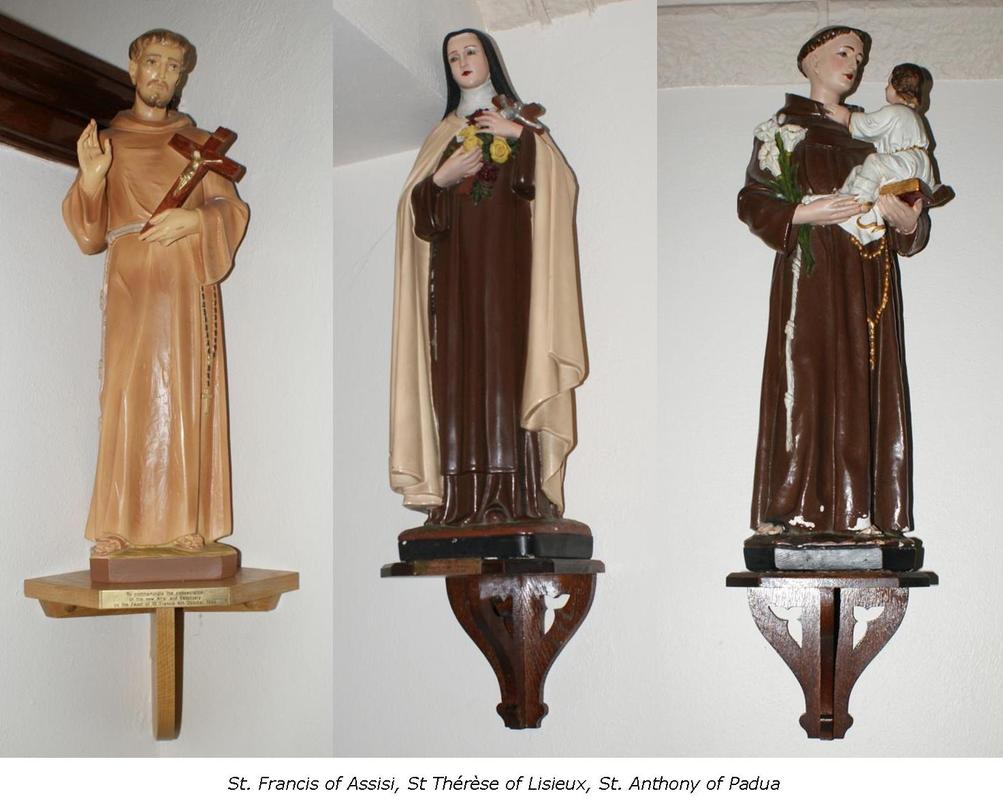|
To the right of the side-door is Saint Francis of Assisi, (‘il Poverello’ or ‘the Little Poor Man’), another Saint marked with the Stigmata, who renounced wealth and privilege for a simple life totally centred on and reliant upon God, thereby founding the Franciscan Order, in Italy. At the back of the church, to the left, is Saint Thérèse of Lisieux, a French Carmelite Nun, often called ‘The Little Flower’ (Although not a timid Soul!!). Through her ‘Little Way’ she shows us how every life, however ‘insignificant’ anyone may consider it, can be lived for and offered to God; not one of us, unless we choose, can fail to get to Heaven; each of us, as Saint Josemaria Escriva, founder of Opus Dei, also taught, is called by God to be holy, doing what we can whenever and wherever God calls us to be. This Universal Call to Holiness was later, again, proclaimed by the Fathers of the Second Vatican Council. Across the church, near to the Confessional, is Saint Anthony of Padua, a monk born in Portugal who died in Italy, often referred to as ‘the Wonder-worker’ and often prayed to when things go missing.
When you go to Confession you will see, in the Reconciliation Room, statues of Saint Anne with her little Daughter, Our Lady and The Infant Jesus of Prague (from the Czech Republic). Prior to the re-ordering of our church, this area was, as some may remember, the site of the Baptistery, hence the stained glass window, seen to one’s right as one enters the room, depicting the Baptism of the Lord by Saint John the Baptist, a very appropriate image when we consider that, through Confession, Grace first received in Baptism is increased or even restored. Why not research a Saint or a particular devotion to Our Lord or Our Lady originating in the Country in which you may have Roots! Our Parish is truly blessed through the many Races and Cultures which contribute to our thriving Community! “Catholic”, after all, means “Universal”, i.e. for all People / Races / Nations! Before arriving at the Blessed-Sacrament Altar we may light a ‘candle’ at the Sacred Heart Shrine (a candle was first lit for us at our Baptism), a sign of the Light of Christ in our Souls); this statue, revealed by Our Lord to Saint Margaret-Mary Alacoque, shows His Heart pierced by the spear and Crowned with Thorns, recalling the intense Love for us which drove Him to Suffer and Die on the Cross. He asked Saint Margaret-Mary to spread devotion to His Heart, so saving the souls of many who had once doubted or even rejected his Love. At Christmas we see displayed here, for our veneration, the Nativity scene while, over the side-door opposite, the Three Kings journey towards Bethlehem for the Feast of the Epiphany of the Lord, when Christ was revealed as Saviour of the World’s Peoples. The pair of doors with a Cross and light above them next to the Sacred Heart Shrine are entrances to another small private room where, if there are several priests available, confessions may also be heard. Near to the Blessed Sacrament Altar is Saint Patrick, Missionary to and Patron Saint of Ireland, ever listening for prayers for that Land where so many of us have our Roots. Also, spaced round the wall of the church you will see 12 candles and 12 crosses. These signify the Twelve Apostles who Jesus called to be the first Priests and Bishops of the Catholic Church. These crosses mark the places anointed by the Archbishop with Chrism (Holy oil) when he consecrated (specially dedicated or gave) our church to God’s Service. We, too, were anointed with this Holy Oil at our Baptism and, later, at our Confirmation. These candles will be lighted on certain occasions such as the Anniversary of the dedication (naming) of the Church by our Archbishop, at the Easter Vigil, representing the Risen Christ, and at Midnight and Christmas Day Masses, representing Christ, the Light of the World who helps us ‘see’ the way to Heaven. Looking away from the High-Altar, up towards the choir-gallery, we see the circular (rose) window, depicting Christ the King (part of this image is also on our Parish Website), Whose Feast brings to a close each Liturgical Year. Comments are closed.
|
From St. Bart'sThoughts on the traditional teachings, devotions, seasons and matters of the Catholic Church Categories
All
Archives
November 2019
|
Roman Catholic Archdiocese of Southwark
A Registered Incorporated Charity - CIO No. 1173050
A Registered Incorporated Charity - CIO No. 1173050
|
Accessibility - St. Bartholomew's does its utmost to accommodate those with additional needs. Whilst the main body of the church is wholly accessible to people with mobility disabilities, the choir gallery is both approached by stairs and the seating is then stepped by design. The church has a wheelchair-accessible toilet, and baby-changing facilities. There is a Loop System (AFIL) in place in the church.
St. Bartholomew's Catholic Church cannot be held responsible for the content of links to external sites. To contact the church and our priests, click here. For Website-related matters only, click here. |
Website Copyright © St. Bartholomew's Roman Catholic Church and/or the Roman Catholic Archdiocese of Southwark 2016 - 2024


 RSS Feed
RSS Feed
